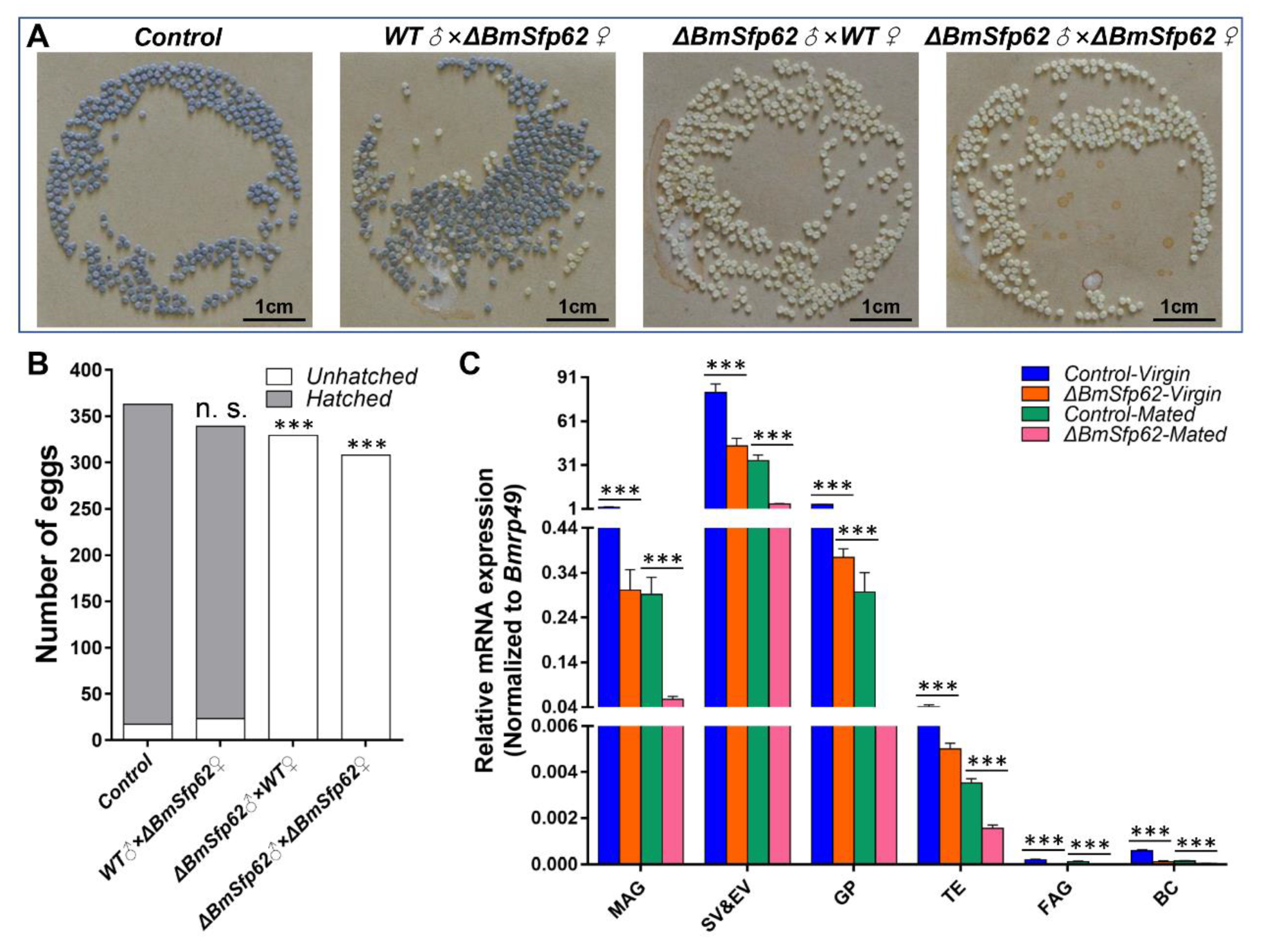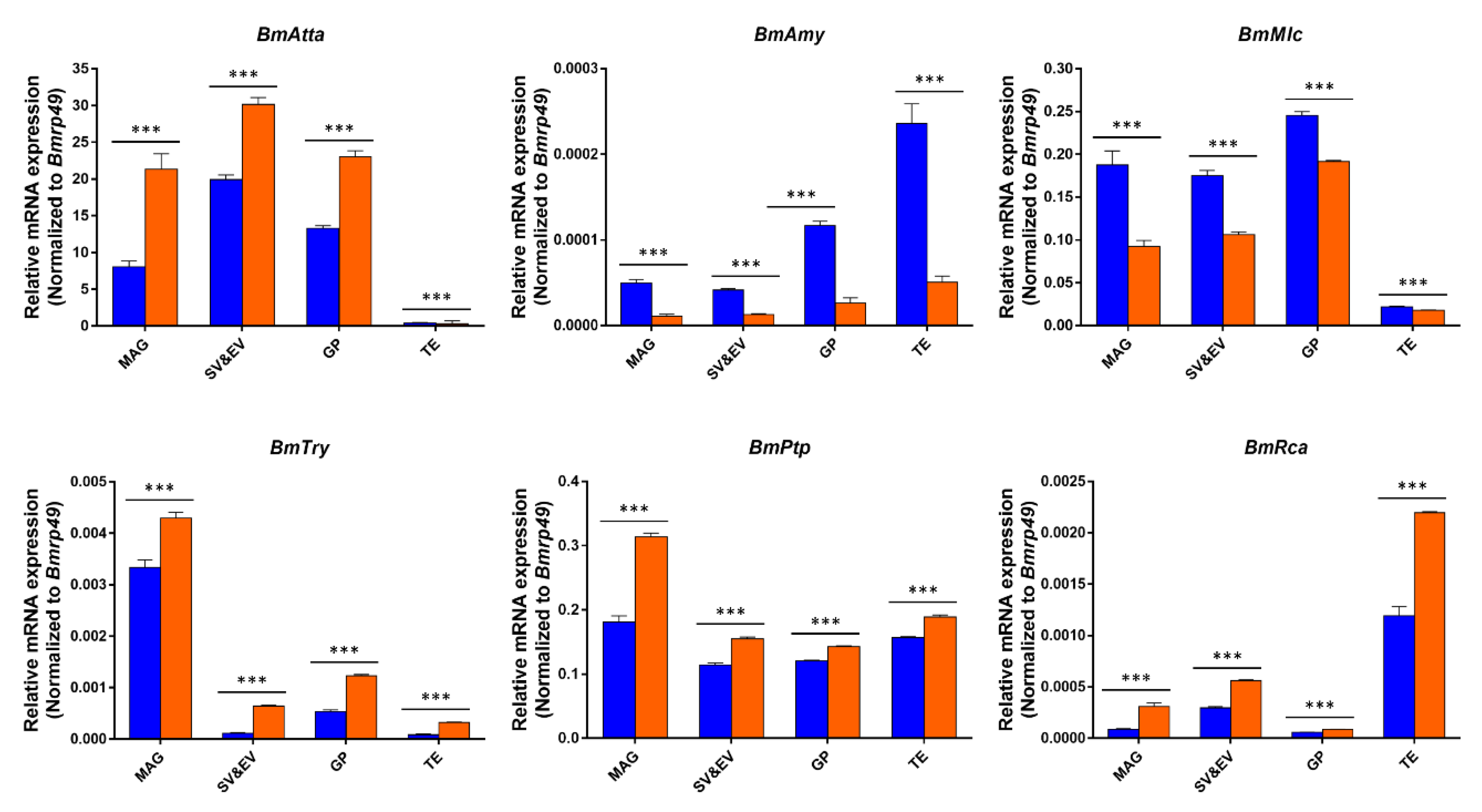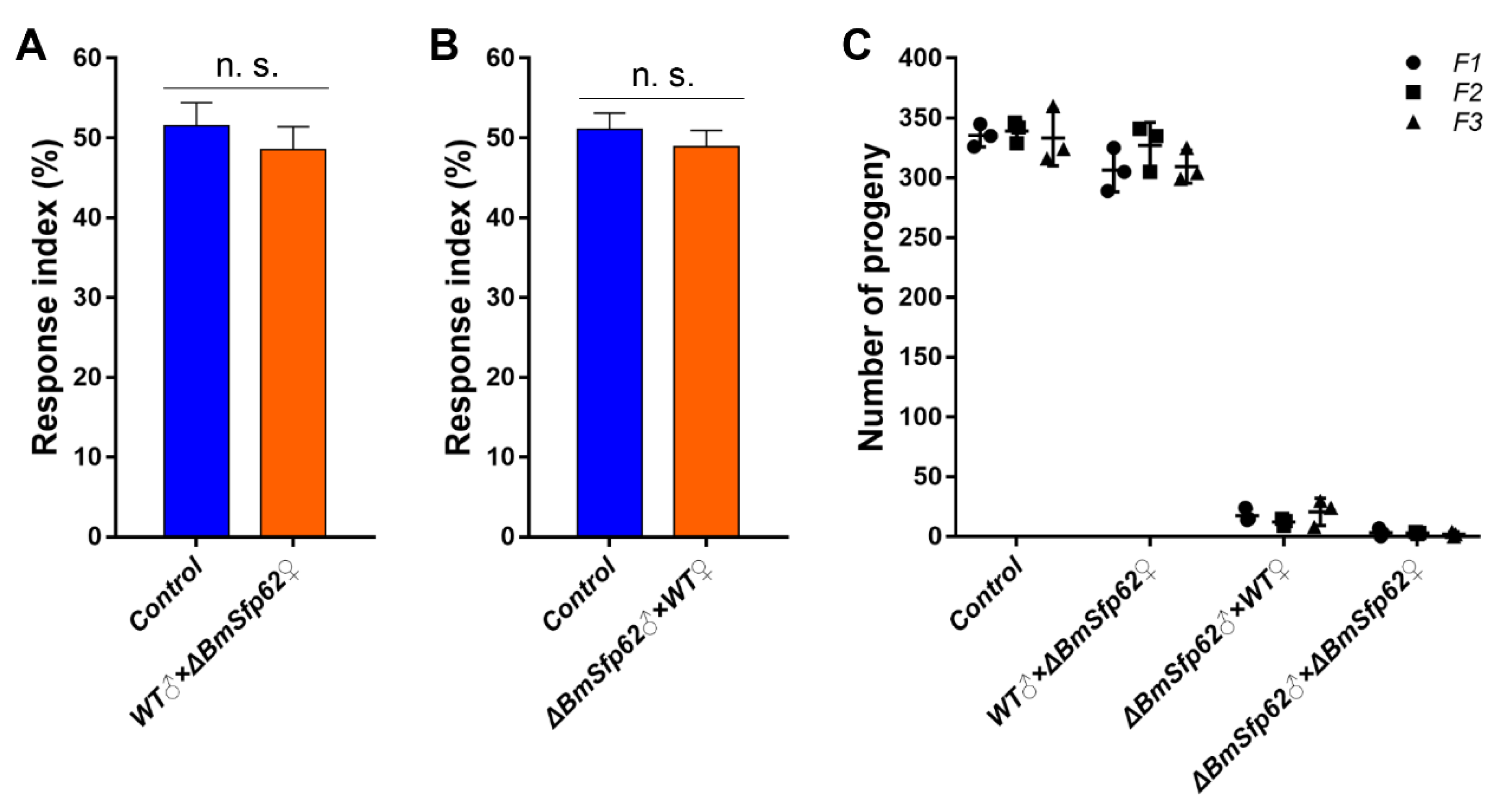CRISPR/Cas9 Mediated Disruption of Seminal Fluid Protein Sfp62 Induces Male Sterility in Bombyx mori
Abstract
:Simple Summary
Abstract
1. Introduction
2. Materials and Methods
2.1. Silkworm Strains and Rearing
2.2. Evolutionary Analysis
2.3. Quantitative Detection of Genes
2.4. Plasmid Construction
2.5. Mutant Construction
2.6. Mutagenesis Analysis
2.7. Sperm Motility and Germline Transmission Assay
2.8. Statistical Analysis
3. Results
3.1. Phylogenetic Identification of Sfp62
3.2. Expression Pattern of BmSfp62
3.3. CRISPR/Cas9-Mediated BmSfp62 Mutation Leads to Male Sterility
3.4. ΔBmSfp62 Sperm Motility Is Decreased and SPF Expression Is Altered
3.5. Mutation of BmSfp62 Does Not Affect Adult Competitiveness and Is Stably Inherited
4. Discussion
5. Conclusions
Supplementary Materials
Author Contributions
Funding
Institutional Review Board Statement
Informed Consent Statement
Data Availability Statement
Conflicts of Interest
References
- Davidovics, R.; Saw, Y.L.; Brown, C.O.; Prinz, M.; McKiernan, H.E.; Danielson, P.B.; Legg, K.M. High-throughput seminal fluid identification by automated immunoaffinity mass spectrometry. J. Forensic. Sci. 2022, 1–7. [Google Scholar] [CrossRef] [PubMed]
- Laflamme, B.A.; Wolfner, M.F. Identification and function of proteolysis regulators in seminal fluid. Mol. Reprod. Dev. 2013, 80, 80–101. [Google Scholar] [CrossRef] [Green Version]
- Findlay, G.D.; Sitnik, J.L.; Wang, W.; Aquadro, C.F.; Clark, N.L.; Wolfner, M.F. Evolutionary rate covariation identifies new members of a protein network required for Drosophila melanogaster female post-mating responses. PLoS Genet. 2014, 10, e1004108. [Google Scholar] [CrossRef] [PubMed] [Green Version]
- Ram, K.R.; Wolfner, M.F. Sustained post-mating response in Drosophila melanogaster requires multiple seminal fluid proteins. PLoS Genet. 2007, 3, e238. [Google Scholar] [CrossRef] [PubMed] [Green Version]
- Sitaram, N.; Nagaraj, R. Seminal plasmin. Bioessays 1995, 17, 415–422. [Google Scholar] [CrossRef] [PubMed]
- Amaro, I.A.; Ahmed-Braimah, Y.H.; League, G.P.; Pitcher, S.A.; Avila, F.W.; Cruz, P.C.; Harrington, L.C.; Wolfner, M.F. Seminal fluid proteins induce transcriptome changes in the Aedes aegypti female lower reproductive tract. BMC Genom. 2021, 22, 896. [Google Scholar] [CrossRef] [PubMed]
- Ramm, S.A. Seminal fluid and accessory male investment in sperm competition. Philos. Trans. R. Soc. Lond. B Biol. Sci. 2020, 375, 20200068. [Google Scholar] [CrossRef]
- Sirot, L.K. On the evolutionary origins of insect seminal fluid proteins. Gen. Comp. Endocrinol. 2019, 278, 104–111. [Google Scholar] [CrossRef] [PubMed]
- Robertson, S.A. Seminal fluid signaling in the female reproductive tract: Lessons from rodents and pigs. J. Anim. Sci. 2007, 85, E36–E44. [Google Scholar] [CrossRef]
- Druart, X.; de Graaf, S. Seminal plasma proteomes and sperm fertility. Anim. Reprod. Sci. 2018, 194, 33–40. [Google Scholar] [CrossRef] [PubMed]
- Minhas, S.; Bettocchi, C.; Boeri, L.; Capogrosso, P.; Carvalho, J.; Cilesiz, N.C.; Cocci, A.; Corona, G.; Dimitropoulos, K.; Gul, M.; et al. European Association of Urology Guidelines on Male Sexual and Reproductive Health: 2021 Update on Male Infertility. Eur. Urol. 2021, 80, 603–620. [Google Scholar] [CrossRef] [PubMed]
- Brown, C.O.; Robbins, B.L.; McKiernan, H.E.; Danielson, P.B.; Legg, K.M. Direct seminal fluid identification by protease-free high-resolution mass spectrometry. J. Forensic. Sci. 2021, 66, 1017–1023. [Google Scholar] [CrossRef] [PubMed]
- Rodriguez-Martinez, H.; Kvist, U.; Ernerudh, J.; Sanz, L.; Calvete, J.J. Seminal plasma proteins: What role do they play? Am. J. Reprod. Immunol. 2011, 66 (Suppl. 1), 11–22. [Google Scholar] [CrossRef] [PubMed] [Green Version]
- Costello, S.; Michelangeli, F.; Nash, K.; Lefievre, L.; Morris, J.; Machado-Oliveira, G.; Barratt, C.; Kirkman-Brown, J.; Publicover, S. Ca2+-stores in sperm: Their identities and functions. Reproduction 2009, 138, 425–437. [Google Scholar] [CrossRef] [Green Version]
- Altschul, S.F.; Madden, T.L.; Schaffer, A.A.; Zhang, J.; Zhang, Z.; Miller, W.; Lipman, D.J. Gapped BLAST and PSI-BLAST: A new generation of protein database search programs. Nucleic. Acids Res. 1997, 25, 3389–3402. [Google Scholar] [CrossRef] [Green Version]
- Lamas-Toranzo, I.; Hamze, J.G.; Bianchi, E.; Fernandez-Fuertes, B.; Perez-Cerezales, S.; Laguna-Barraza, R.; Fernandez-Gonzalez, R.; Lonergan, P.; Gutierrez-Adan, A.; Wright, G.J.; et al. TMEM95 is a sperm membrane protein essential for mammalian fertilization. Elife 2020, 9, e53913. [Google Scholar] [CrossRef]
- Noda, T.; Lu, Y.; Fujihara, Y.; Oura, S.; Koyano, T.; Kobayashi, S.; Matzuk, M.M.; Ikawa, M. Sperm proteins SOF1, TMEM95, and SPACA6 are required for sperm-oocyte fusion in mice. Proc. Natl. Acad. Sci. USA 2020, 117, 11493–11502. [Google Scholar] [CrossRef]
- Deneke, V.E.; Pauli, A. The Fertilization Enigma: How Sperm and Egg Fuse. Annu. Rev. Cell Dev. Biol. 2021, 37, 391–414. [Google Scholar] [CrossRef]
- Loir, M.; Labbe, C.; Maisse, G.; Pinson, A.; Boulard, G.; Mourot, B.; Chambeyron, F. Proteins of seminal fluid and spermatozoa in the trout (Oncorhynchus mykiss): Partial characterization and variations. Fish Physiol. Biochem. 1990, 8, 485–495. [Google Scholar] [CrossRef]
- Rasmussen, T.H.; Korsgaard, B. Estrogenic octylphenol affects seminal fluid production and its biochemical composition of eelpout (Zoarces viviparus). Comp. Biochem. Physiol. Part C Toxicol. Pharmacol. 2004, 139, 1–10. [Google Scholar] [CrossRef]
- Yu, S.; Kojima, N.; Hakomori, S.I.; Kudo, S.; Inoue, S.; Inoue, Y. Binding of rainbow trout sperm to egg is mediated by strong carbohydrate-to-carbohydrate interaction between (KDN)GM3 (deaminated neuraminyl ganglioside) and Gg3-like epitope. Proc. Natl. Acad. Sci. USA 2002, 99, 2854–2859. [Google Scholar] [CrossRef] [PubMed] [Green Version]
- Mochida, K.; Kondo, T.; Matsubara, T.; Adachi, S.; Yamauchi, K. A high molecular weight glycoprotein in seminal plasma is a sperm immobilizing factor in the teleost Nile tilapia, Oreochromis niloticus. Dev. Growth Differ. 1999, 41, 619–627. [Google Scholar] [CrossRef] [PubMed] [Green Version]
- Binner, M.I.; Kogan, A.; Panser, K.; Schleiffer, A.; Deneke, V.E.; Pauli, A. The Sperm Protein Spaca6 is Essential for Fertilization in Zebrafish. Front. Cell Dev. Biol. 2021, 9, 806982. [Google Scholar] [CrossRef]
- Koppik, M.; Fricke, C. Gene expression changes in male accessory glands during ageing are accompanied by reproductive decline in Drosophila melanogaster. Mol. Ecol. 2017, 26, 6704–6716. [Google Scholar] [CrossRef] [PubMed]
- Carmel, I.; Tram, U.; Heifetz, Y. Mating induces developmental changes in the insect female reproductive tract. Curr. Opin. Insect Sci. 2016, 13, 106–113. [Google Scholar] [CrossRef] [PubMed]
- Simmons, L.W.; Beveridge, M.; Li, L.; Tan, Y.F.; Millar, A.H. Ontogenetic changes in seminal fluid gene expression and the protein composition of cricket seminal fluid. Evol. Dev. 2014, 16, 101–109. [Google Scholar] [CrossRef] [Green Version]
- Gasparini, C.; Marino, I.A.; Boschetto, C.; Pilastro, A. Effect of male age on sperm traits and sperm competition success in the guppy (Poecilia reticulata). J. Evol. Biol. 2010, 23, 124–135. [Google Scholar] [CrossRef]
- Sirot, L.K.; Buehner, N.A.; Fiumera, A.C.; Wolfner, M.F. Seminal fluid protein depletion and replenishment in the fruit fly, Drosophila melanogaster: An ELISA-based method for tracking individual ejaculates. Behav. Ecol. Sociobiol. 2009, 63, 1505–1513. [Google Scholar] [CrossRef] [Green Version]
- Avila, F.W.; Sirot, L.K.; LaFlamme, B.A.; Rubinstein, C.D.; Wolfner, M.F. Insect seminal fluid proteins: Identification and function. Annu. Rev. Entomol. 2011, 56, 21–40. [Google Scholar] [CrossRef] [Green Version]
- Ignotz, G.G.; Cho, M.Y.; Suarez, S.S. Annexins are candidate oviductal receptors for bovine sperm surface proteins and thus may serve to hold bovine sperm in the oviductal reservoir. Biol. Reprod. 2007, 77, 906–913. [Google Scholar] [CrossRef] [Green Version]
- LaFlamme, B.A.; Ram, K.R.; Wolfner, M.F. The Drosophila melanogaster seminal fluid protease “seminase” regulates proteolytic and post-mating reproductive processes. PLoS Genet. 2012, 8, e1002435. [Google Scholar] [CrossRef] [PubMed] [Green Version]
- Ben Chehida, Y.; Denis, B.; Claisse, G.; Joly, D. What the study of seminal fluid proteins in Drosophila tells us about the evolution of reproduction. Med. Sci. 2014, 30, 651–657. [Google Scholar] [CrossRef] [Green Version]
- McGeary, M.K.; Findlay, G.D. Molecular evolution of the sex peptide network in Drosophila. J. Evol. Biol. 2020, 33, 629–641. [Google Scholar] [CrossRef] [PubMed]
- Kubli, E. Sex-peptides: Seminal peptides of the Drosophila male. Cell Mol. Life Sci. 2003, 60, 1689–1704. [Google Scholar] [CrossRef] [PubMed]
- Stephens, K.; Cardullo, R.A.; Thaler, C.D. Culex pipiens sperm motility is initiated by a trypsin-like protease from male accessory glands. Mol. Reprod. Dev. 2018, 85, 440–448. [Google Scholar] [CrossRef] [PubMed]
- Wang, S.; Dos-Santos, A.L.A.; Huang, W.; Liu, K.C.; Oshaghi, M.A.; Wei, G.; Agre, P.; Jacobs-Lorena, M. Driving mosquito refractoriness to Plasmodium falciparum with engineered symbiotic bacteria. Science 2017, 357, 1399–1402. [Google Scholar] [CrossRef] [Green Version]
- Scolari, F.; Gomulski, L.M.; Ribeiro, J.M.; Siciliano, P.; Meraldi, A.; Falchetto, M.; Bonomi, A.; Manni, M.; Gabrieli, P.; Malovini, A.; et al. Transcriptional profiles of mating-responsive genes from testes and male accessory glands of the Mediterranean fruit fly, Ceratitis capitata. PLoS ONE 2012, 7, e46812. [Google Scholar] [CrossRef] [Green Version]
- Simmons, L.W.; Lovegrove, M. Socially cued seminal fluid gene expression mediates responses in ejaculate quality to sperm competition risk. Proc. Biol. Sci. 2017, 284, 20171486. [Google Scholar] [CrossRef]
- Xu, X.; Wang, Y.; Bi, H.; Xu, J.; Liu, Z.; Niu, C.; He, L.; James, A.A.; Li, K.; Huang, Y. Mutation of the seminal protease gene, serine protease 2, results in male sterility in diverse lepidopterans. Insect Biochem. Mol. Biol. 2020, 116, 103243. [Google Scholar] [CrossRef]
- De Castro Poncio, L.; Dos Anjos, F.A.; de Oliveira, D.A.; Rebechi, D.; de Oliveira, R.N.; Chitolina, R.F.; Fermino, M.L.; Bernardes, L.G.; Guimaraes, D.; Lemos, P.A.; et al. Novel Sterile Insect Technology Program Results in Suppression of a Field Mosquito Population and Subsequently to Reduced Incidence of Dengue. J. Infect. Dis. 2021, 224, 1005–1014. [Google Scholar] [CrossRef]
- Marec, F.; Vreysen, M.J.B. Advances and Challenges of Using the Sterile Insect Technique for the Management of Pest Lepidoptera. Insects 2019, 10, 371. [Google Scholar] [CrossRef] [PubMed] [Green Version]
- Bieniek, J.M.; Drabovich, A.P.; Lo, K.C. Seminal biomarkers for the evaluation of male infertility. Asian J. Androl. 2016, 18, 426–433. [Google Scholar] [CrossRef] [PubMed]
- Benedict, M.Q. Sterile Insect Technique: Lessons From the Past. J. Med. Entomol. 2021, 58, 1974–1979. [Google Scholar] [CrossRef] [PubMed]
- Komor, A.C.; Badran, A.H.; Liu, D.R. CRISPR-Based Technologies for the Manipulation of Eukaryotic Genomes. Cell 2017, 168, 20–36. [Google Scholar] [CrossRef] [PubMed] [Green Version]
- Roscoe, L.E.; Silk, P.; Eveleigh, E.S. Evidence of Male Hair Pencil Pheromone in Choristoneura fumiferana (Lepidoptera: Tortricidae). J. Insect Sci. 2016, 16, 27. [Google Scholar] [CrossRef] [Green Version]
- Tan, A.; Tanaka, H.; Tamura, T.; Shiotsuki, T. Precocious metamorphosis in transgenic silkworms overexpressing juvenile hormone esterase. Proc. Natl. Acad. Sci. USA 2005, 102, 11751–11756. [Google Scholar] [CrossRef] [Green Version]
- Saitou, N.; Nei, M. The neighbor-joining method: A new method for reconstructing phylogenetic trees. Mol. Biol. Evol. 1987, 4, 406–425. [Google Scholar] [CrossRef] [PubMed]
- Zuckerkandl, E. Evolutionary divergence and convergence in proteins. In Evolving Genes & Proteins; Academic Press: New York, NY, USA, 1965. [Google Scholar]
- Kumar, S.; Stecher, G.; Li, M.; Knyaz, C.; Tamura, K. MEGA X: Molecular Evolutionary Genetics Analysis across Computing Platforms. Mol. Biol. Evol. 2018, 35, 1547–1549. [Google Scholar] [CrossRef]
- Hwang, W.Y.; Fu, Y.; Reyon, D.; Maeder, M.L.; Tsai, S.Q.; Sander, J.D.; Peterson, R.T.; Yeh, J.R.; Joung, J.K. Efficient genome editing in zebrafish using a CRISPR-Cas system. Nat. Biotechnol. 2013, 31, 227–229. [Google Scholar] [CrossRef] [PubMed]
- Doudna, J.A.; Charpentier, E. Genome editing. The new frontier of genome engineering with CRISPR-Cas9. Science 2014, 346, 1258096. [Google Scholar] [CrossRef]
- Hsu, P.D.; Lander, E.S.; Zhang, F. Development and applications of CRISPR-Cas9 for genome engineering. Cell 2014, 157, 1262–1278. [Google Scholar] [CrossRef] [PubMed] [Green Version]
- Xu, J.; Chen, R.M.; Chen, S.Q.; Chen, K.; Tang, L.M.; Yang, D.H.; Yang, X.; Zhang, Y.; Song, H.S.; Huang, Y.P. Identification of a germline-expression promoter for genome editing in Bombyx mori. Insect Sci. 2018, 26, 991–999. [Google Scholar] [CrossRef]
- Rodriguez-Martinez, H.; Martinez, E.A.; Calvete, J.J.; Pena Vega, F.J.; Roca, J. Seminal Plasma: Relevant for Fertility? Int. J. Mol. Sci. 2021, 22, 4368. [Google Scholar] [CrossRef] [PubMed]
- Ma, Y.W.; Zhang, L.F.; Huang, X.X. Genome modification by CRISPR/Cas9. FEBS J. 2014, 281, 5186–5193. [Google Scholar] [CrossRef] [PubMed]
- Manghwar, H.; Lindsey, K.; Zhang, X.; Jin, S. CRISPR/Cas System: Recent Advances and Future Prospects for Genome Editing. Trends. Plant. Sci. 2019, 24, 1102–1125. [Google Scholar] [CrossRef] [Green Version]
- McGraw, L.A.; Gibson, G.; Clark, A.G.; Wolfner, M.F. Genes regulated by mating, sperm, or seminal proteins in mated female Drosophila melanogaster. Curr. Biol. 2004, 14, 1509–1514. [Google Scholar] [CrossRef] [Green Version]
- Furusawa, M.; Ohnishi, T.; Taira, T.; Iguchi-Ariga, S.M.; Ariga, H. AMY-1, a c-Myc-binding protein, is localized in the mitochondria of sperm by association with S-AKAP84, an anchor protein of cAMP-dependent protein kinase. J. Biol. Chem. 2001, 276, 36647–36651. [Google Scholar] [CrossRef] [PubMed] [Green Version]
- McGraw, L.A.; Clark, A.G.; Wolfner, M.F. Post-mating gene expression profiles of female Drosophila melanogaster in response to time and to four male accessory gland proteins. Genetics 2008, 179, 1395–1408. [Google Scholar] [CrossRef] [Green Version]
- Chakravorty, S.; Vu, H.; Foelber, V.; Vigoreaux, J.O. Mutations of the Drosophila myosin regulatory light chain affect courtship song and reduce reproductive success. PLoS ONE 2014, 9, e90077. [Google Scholar] [CrossRef] [PubMed] [Green Version]
- Sitnik, J.L.; Gligorov, D.; Maeda, R.K.; Karch, F.; Wolfner, M.F. The Female Post-Mating Response Requires Genes Expressed in the Secondary Cells of the Male Accessory Gland in Drosophila melanogaster. Genetics 2016, 202, 1029–1041. [Google Scholar] [CrossRef] [PubMed] [Green Version]
- Sugahara, R.; Jouraku, A.; Nakakura, T.; Minaba, M.; Yamamoto, T.; Shinohara, Y.; Miyoshi, H.; Shiotsuki, T. Tissue-specific expression and silencing phenotypes of mitochondrial phosphate carrier paralogues in several insect species. Insect Mol. Biol. 2017, 26, 332–342. [Google Scholar] [CrossRef]
- Silva, A.M.S.; Socorro, S.; Hurtado de Llera, A.; Vaz, C.V.; Correia, S.; Maia, C.J. Overexpression of regucalcin mitigates the ageing-related changes in oxidative stress and sperm quality. Theriogenology 2020, 157, 472–482. [Google Scholar] [CrossRef] [PubMed]
- Primakoff, P.; Myles, D.G. Penetration, adhesion, and fusion in mammalian sperm-egg interaction. Science 2002, 296, 2183–2185. [Google Scholar] [CrossRef] [PubMed] [Green Version]
- Scolari, F.; Khamis, F.M.; Perez-Staples, D. Beyond Sperm and Male Accessory Gland Proteins: Exploring Insect Reproductive Metabolomes. Front. Physiol. 2021, 12, 729440. [Google Scholar] [CrossRef] [PubMed]






| Primer Name | Primer Sequence (5′-3′) |
|---|---|
| qRT-PCR analysis | |
| BmSfp62-F | GGCCCTTCCTATACACGTCA |
| BmSfp62-R | CGTCACTATCGTTTGCAGCA |
| BmAtta-F | GCGGACTGGACTACATGTTC |
| BmAtta-R | TCAAACTTCTTGAAGCCGGC |
| BmAmy-F | CATGGGTGTTGCTGGTTTCA |
| BmAmy-R | TGCGACTGATAGCTTCACCA |
| BmMlc-F | TCCCATCTACAGCCAAGCAA |
| BmMlc-R | TAGGGGATCATGCCGTCATC |
| BmTry-F | CGTACCGACTTTCAGGAGGA |
| BmTry-R | CAGATGATGTGGTGCCTTCG |
| BmPtp-F | CGCCGAGAAGTACAAGAACG |
| BmPtp-R | TACGGTAAGTGTAGGCGGTC |
| BmRca-F | ATGACCATAGACACGGACGG |
| BmRca-R | TTCATAGAGGCGGAGGTCAC |
| BmRP49-F | TCAATCGGATCGCTATGACA |
| BmRP49-R | ATGACGGGTCTTCTTGTTGG |
| Plasmid construction | |
| U6-F | CTCACTATAGGGCGAATTGGAGGTTATGTAGTACACATTGTTGTA |
| U6-R | TTTTCTTGTTATAGATATCAAAAAAAGCACCGACTCGGTG |
| Overlap-F | GCTAGCCATTGACTCCGCGGAGGTTATGTAGTACACATTGTTGTA |
| Overlap-R | CCGCGGAGTCAATGGCTAGCAAAAAAGCACCGACTCGGTG |
| Sg1-F | GGTAAGTCCCACAGTTGTCAGTTTTAGAGCTAGAAATAGCAAGTT |
| Sg1-R | TGACAACTGTGGGACTTACCACTTGTAGAGCACGATATTTTGTAT |
| Sg2-F | GGGGTATCACTCACGAAGAGGTTTTAGAGCTAGAAATAGCAAGTT |
| Sg2-R | CTCTTCGTGAGTGATACCCCACTTGTAGAGCACGATATTTTGTAT |
| Identification of mutations | |
| TS-F | ATGCAGAATGACCACGGTGGG |
| TS-R | CGTCGAGCCCTTCGTCTCAA |
Publisher’s Note: MDPI stays neutral with regard to jurisdictional claims in published maps and institutional affiliations. |
© 2022 by the authors. Licensee MDPI, Basel, Switzerland. This article is an open access article distributed under the terms and conditions of the Creative Commons Attribution (CC BY) license (https://creativecommons.org/licenses/by/4.0/).
Share and Cite
Xu, X.; Chen, J.; Du, X.; Yao, L.; Wang, Y. CRISPR/Cas9 Mediated Disruption of Seminal Fluid Protein Sfp62 Induces Male Sterility in Bombyx mori. Biology 2022, 11, 561. https://doi.org/10.3390/biology11040561
Xu X, Chen J, Du X, Yao L, Wang Y. CRISPR/Cas9 Mediated Disruption of Seminal Fluid Protein Sfp62 Induces Male Sterility in Bombyx mori. Biology. 2022; 11(4):561. https://doi.org/10.3390/biology11040561
Chicago/Turabian StyleXu, Xia, Jine Chen, Xin Du, Lusong Yao, and Yongqiang Wang. 2022. "CRISPR/Cas9 Mediated Disruption of Seminal Fluid Protein Sfp62 Induces Male Sterility in Bombyx mori" Biology 11, no. 4: 561. https://doi.org/10.3390/biology11040561
APA StyleXu, X., Chen, J., Du, X., Yao, L., & Wang, Y. (2022). CRISPR/Cas9 Mediated Disruption of Seminal Fluid Protein Sfp62 Induces Male Sterility in Bombyx mori. Biology, 11(4), 561. https://doi.org/10.3390/biology11040561






